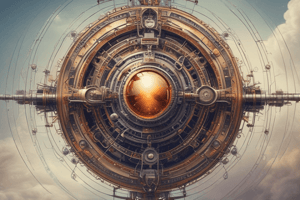Podcast
Questions and Answers
किस विज्ञानशास्त्र में जोर, गति और उस पर लगने वाले बलों के बीच के संबंधों पर ध्यान केंद्रित है?
किस विज्ञानशास्त्र में जोर, गति और उस पर लगने वाले बलों के बीच के संबंधों पर ध्यान केंद्रित है?
- रिलेटिविस्टिक सांद्रता
- आधुनिक सांद्रता
- सांख्यिकीय सांद्रता
- क्लासिकल सांद्रता (correct)
कौन-कौन से तत्व न्यूटनियन मैकेनिक्स के महत्वपूर्ण घटक हैं?
कौन-कौन से तत्व न्यूटनियन मैकेनिक्स के महत्वपूर्ण घटक हैं?
- मोमेंटम का संरक्षण (correct)
- केंद्रोणीय गति
- ऊर्ध्वाधर गति
- क्षैतिज गति
डायनामिक्स में किन्होंने अक्षमता (kinematics) की महत्वपूर्णता को समझाया है?
डायनामिक्स में किन्होंने अक्षमता (kinematics) की महत्वपूर्णता को समझाया है?
- अरस्तु
- प्लाटो
- न्यूटन (correct)
- समुख
किन-किन गुणों की अध्ययन के माध्यम से गति का मात्रात्मक अध्ययन होता है?
किन-किन गुणों की अध्ययन के माध्यम से गति का मात्रात्मक अध्ययन होता है?
किसका सूत्र बताता है कि बल () = मास () x त्वरण ()?
किसका सूत्र बताता है कि बल () = मास () x त्वरण ()?
संरक्षण सिद्धांत के अनुसार, एक वस्तु की कुल ऊर्जा के साथ क्या होता है?
संरक्षण सिद्धांत के अनुसार, एक वस्तु की कुल ऊर्जा के साथ क्या होता है?
क्या टॉर्क के संबंध में सही है?
क्या टॉर्क के संबंध में सही है?
किसे 'मेकेनिक्स' में 'नेनो-, माइक्रो-, और मेजोमेकेनिक्स' समेत 'प्रमुख' अंश कहा जाता है?
किसे 'मेकेनिक्स' में 'नेनो-, माइक्रो-, और मेजोमेकेनिक्स' समेत 'प्रमुख' अंश कहा जाता है?
महत्वपूर्ण संकेत 'मोमेंट' को कैसे परिभाषित किया जा सकता ह।
महत्वपूर्ण संकेत 'मोमेंट' को कैसे परिभाषित किया जा सकता ह।
'सम्प्रेषित' का क्या मतलब है, सम्मुक्त कीजिये?
'सम्प्रेषित' का क्या मतलब है, सम्मुक्त कीजिये?
Flashcards are hidden until you start studying
Study Notes
Exploring Mechanics in Physics
Mechanics, a core branch of physics, focuses on the motion of objects, how forces act upon them, and the resulting interactions among entities within our natural world. Within the broad realm of mechanics, there exist several subcategories, including classical mechanics, statistical mechanics, and modern mechanics—such as relativistic mechanics and quantum mechanics. Let's delve deeper into classical mechanics and its integral components.
Newtonian Mechanics
Sir Isaac Newton's formulation of mechanics remains the bedrock of understanding motion. Key components include:
- Laws of motion, centrally forming (F = ma), where force ((F)) equals mass ((m)) times acceleration ((a)).
- Universal law of gravitation, defining Earth's attraction towards bodies.
- Three laws of motion encompassing conservation of momentum and energy.
Newton's physics is still widely applicable today due to its simplicity yet effectiveness.
Dynamics
Dynamics deals with the relationship between force and movement. Vital aspects of dynamics include kinematics (quantitative study of motion without considering causes) and kinetics (study of the relationships between forces and motions).
In addition to studying vectors, magnitudes, directions, and velocities, various systems are analyzed, such as linear, rotational, and circular motion. Mathematical descriptions employ differential equations and calculus for accurate solutions.
Work and Energy
This aspect measures the change in potential or kinetic energies of bodies as they interact mechanically with other bodies or their surroundings. Conservation of mechanical energy implies an object's total energy remains constant unless acted upon by nonconservative forces, such as friction or air resistance.
Moments and Torques
Torque quantifies the tendency of a force to cause rotation about a fixed axis. Its vector product with the lever arm defines moments; these are crucial for analyzing rigid body rotation.
Researched Topics
While classic mechanics continues to underpin contemporary exploration, significant recent developments deserve mention:
- Nano-, micro, and mesomechanics addressing extremely small scales (nanometers) affecting electronic devices and miniaturized structures.
- Biological mechanics exploring animal movements and cellular processes to enhance biomedical engineering and deepen biological knowledge.
Conclusion
Classical mechanics continues to evolve alongside technological advances, enriching our scientific understanding and daily lives. Future advancements will likely merge classical mechanics with quantum and relativity theories to address complex modern issues.
Studying That Suits You
Use AI to generate personalized quizzes and flashcards to suit your learning preferences.





